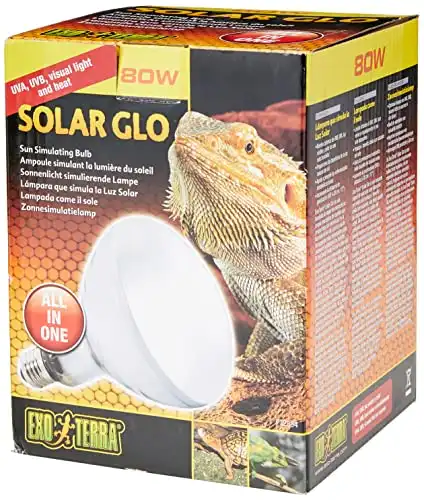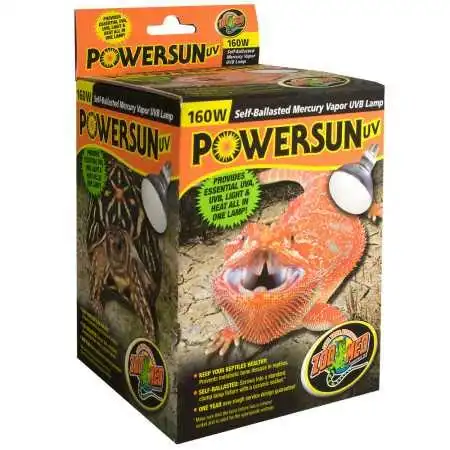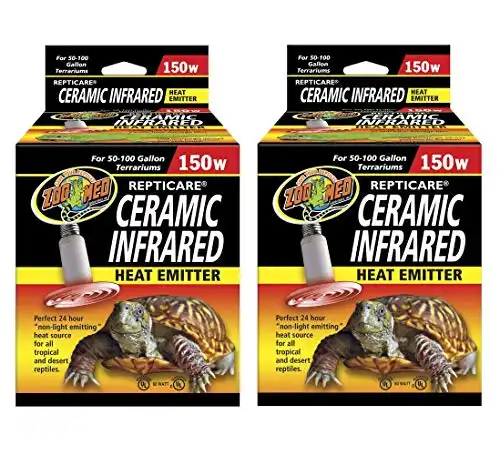
Bearded dragons need heat in captivity in order to thermoregulate. Heat also paves the way for them to digest their
We are going to discuss the best heat lamps for bearded dragons. We tested some of our recommended heat lamps, which genuinely benefit your bearded dragons. We also reviewed the top heat lamp picks of many beardie owners. Read on to find the best heat lamp for your bearded dragon!
Table of Contents
Best Heat Lamps For Bearded Dragons
These are the best heat lamps for bearded dragons based on what they do best:
- Best All-In-One Mercury Vapor Bulb: Exo Terra Solar Glo
- Best Heat Reach: Zoo Med Powersun
- Best Ceramic Heat Emitter: Zoo Med ReptiCare Ceramic Heat Emitter
- Most Affordable Heat Lamp: Repti Zoo Reptile Heat Lamp
The good thing about our recommended heat lamps is that they also emit UVB. Therefore, based on how you set up the enclosure, you may opt not to use another UVB bulb.
These bulbs can also cater to Ferguson zone 3, which is perfect for bearded dragons. This is good to keep in mind when you are setting up the basking spot of the enclosure.
Why Buy A Heat Lamp For Bearded Dragons?
Bearded dragons are cold-blooded reptiles. This means that they do not have the capacity to control their body temperature internally. They need the help of external heat sources in order to thermoregulate.
In captivity, we should provide our bearded dragons with temperature gradients in the enclosure: warm and cool sides. In this way, they can just move from one place to the other when they need to get heat or when they need to cool down.
As bearded dragons are desert-dwelling reptiles, they need a lot of heat. They also utilize heat to digest
Ferguson zones show the UV requirements of your reptiles. There are Ferguson zones 1-4 and depending on the zone that your reptile is in, it shows their needed UVI range and how often they bask. The bearded dragon is in Ferguson zone 3, which are partial or open sun basker reptiles.
Reviews Of The Best Heat Lamps For Bearded Dragons
Let’s have a look at the heat bulbs in detail.
1. Exo Terra Solar Glo
The Exo Terra Solar Glo is one of the bulbs that we were able to test. It is an all-in-one mercury vapor bulb that can provide visual light, UVB, and heat.
As it is a mercury vapor bulb, it is more energy efficient and durable compared to other types of bulbs. Also, it does not need a separate ballast as it has its own integrated circuit.
This bulb fits E26 and E27 sockets. This fixture from Exo Terra fits the bulb perfectly. You can also make use of this dome to accurately concentrate the light and heat in a certain spot in the enclosure.
In our full review here, we tested the 80 watts bulb. You will be pleased to know that the results that we got in terms of heat are higher than their actual claims. This means that you can use this bulb as your main heat source.
Pros
- A three-in-one bulb
- Easy to set up
- Gets hot easily
- Heat is maintained for as long as it is turned on
- Good UVB output
Cons
- You need to replace it every 6 months as it also has UVB
- You cannot set it up horizontally as mercury vapor bulbs can give out when not set up vertically
2. Zoo Med Powersun
The Zoo Med Powersun is also a mercury vapor bulb. It is also a three-in-one bulb as it emits UVA, UVB, and heat.
The threads of the bulb are also plated with nickel so you will not have any problems with corrosion. Keep in mind, the humidity levels of the enclosure may also affect the heat output of the bulbs over time.
So at least with this bulb, you have an extra precaution against that.
It fits into a standard ceramic socket (click here) which is an E26 or E27. Further, it has the best heat reach as its output is not just concentrated in a certain spot. With this, you are assured that the heat of the
We tested the 100 watts bulb and we found out that the heat it gives is a bit lower compared to the Exo Terra Solar Glo. However, its heat output would still be perfect for open baskers or desert-dwelling reptiles.
Pros
- Heat output has a wide reach
- Easy to set up
- Can work well in bigger enclosures
Cons
- The bulb may be sensitive to movement so it has the tendency to turn off, but it will switch on again after a while.
- You need to replace it every 6 months as it also emits UVB
3. Zoo Med ReptiCare Ceramic Heat Emitter
The Zoo Med ReptiCare Ceramic Heat Emitter is a great source of heat especially if you live in colder areas. This one only emits heat but does not provide light. Therefore, you need to have a separate visual light and UVB light in the enclosure.
This is a good option if you live in an area where it gets cold easily or if you put the enclosure in a place that is naturally cold like the basement or an air-conditioned room.
The heat output of this bulb is strong so if you plan to use this as the main source of heat, it is best to use a porcelain socket with a wider head (like this one) so that the socket can withstand the heat and that the heat will also scatter.
Important note: It is best to use a timer when using a ceramic heat emitter especially if you will also use it at night. Using a timer decreases the risk of overheating the
tank .
Pros
- Strong heat output
- Great for bigger enclosures
- Lasts longer than other bulbs
- Easy to set up
Cons
- Can overheat the enclosure when not used properly
- Does not emit light
- Does not provide UVB
4. Repti Zoo Reptile Heat Lamp
You might be surprised that this affordable heat lamp is a four-in-one bulb. It emits visual light, UVA, UVB, and heat. The heat output of this bulb is perfect for small to medium enclosures, however, it may be too strong for a nano enclosure.
If you house a baby bearded dragon in a nano enclosure, this bulb may still work but you need to use a standing lamp holder to lift the bulb a couple of inches away from the top of the enclosure.
On the other hand, if you plan to use this on a bigger enclosure, you may need to use two bulbs or use a ceramic heat emitter. This lamp fixture will help with that as the bulb can also fit a standard ceramic socket.
Pros
- Affordable
- Good heat output
- Works well in small to medium enclosures
- Low risk of overheating
Cons
- You need to change the bulb every 6 months as it also emits UVB
- UVB output is not that strong, so it is better to be used for its heat
Which Heat Lamp Wattage Should I Buy?
You may think that getting a higher-wattage bulb is the best option to properly heat the enclosure. However, there are three factors to consider when choosing a wattage. These are the following:
Size Of The Enclosure
If you have a small enclosure, it means that there is less space to heat. Therefore, you can opt for a lower wattage for the bulb. As opposed to having a bigger enclosure where you need a higher wattage because there is more space to heat.
| Enclosure Size (Gallons) | Bulb Wattage |
| 10 gallons | 25 watts |
| 20 gallons | 50 watts |
| 30 gallons | 75 watts |
| 40 gallons | 100 watts |
| 50 gallons | 125 watts (one 100w bulb and one 25w bulb/other supplemental heat sources) |
| 75 gallons | 187.5 watts (one 100w bulb and one 80w bulb/other supplemental heat sources) |
| 100 gallons | 250 watts (two 100w bulbs and one 50w bulb/other supplemental heat sources) |
| 120 gallons | 300 watts (three 100w bulbs/ two 100w bulbs and ceramic heat emitter/other supplemental heat sources) |
There is no exact measurement for the bulb wattages based on the size of your enclosure. The baseline is a 100w bulb is sufficient for a 40-gallon
In the event that you need to add other heat sources, you have to do trial and error in measuring the temperature in the enclosure. You can use a temp gun like this one to make the process easier.
Heat Lamp Fixture

You should also consider the wattage of the bulb that you plan to use as well as the lamp fixture or dome that you are going to pair with it.
Additionally, the material of the socket is also important based on the type of bulb that you are going to choose.
For ceramic heat emitters, it is best to go with a porcelain socket lamp fixture so that the socket will not melt. As for mercury vapor bulbs, a ceramic socket lamp fixture will do.
Environment
Another thing that makes heat lamp wattage a bit tricky to estimate or determine is the fact that the environment that your
For example, if your
On the other hand, if you have a
Therefore to be sure, check the ambient temperatures inside the
How Much Heat Do Bearded Dragons Need?
In general, bearded dragons should have a temperature of 104-107 °F in the basking spot and 71-77 °F in the cool spot.
A good indication that you have the heating and lighting requirements properly set up is that your bearded dragon will stay in the hot areas of the enclosure during the day, and will move to the cooler side before the sun sets.
How Long Can Bearded Dragons Survive Without Heat?

Bearded dragons can survive 24 hours without heat just as long as the temperature in the enclosure does not go below 65 °F.
However, if the temperature of the enclosure drops below 65 °F, your bearded dragon may survive for 10-12 hours depending on its health status, but it will develop respiratory problems.
Further, if it is left for an extended period without any source of heat, your bearded dragon may die. So it is best to always have extra heat lamps ready in case your current one burns out.
When Do We Replace The Heat Lamps For Bearded Dragons?
If you have a heat lamp that also emits UVB, and it is also the sole source of UVB for your bearded dragon, then it is best to change it every 6 months.
The UVB output decreases through consistent use so by the 6th month, the UVB output may not be accurate.
On the other hand, if your mercury vapor heat lamp that also emits UVB is not your main source of UVB for the
Ceramic heat emitters last longer than other light-emitting bulbs. They can last for two to five years. It is still best to check what is stated in the box of your chosen bulb just to make sure when you need to replace them.
Tip: Also have a look at our guide on the best UVB lamps for bearded dragons here!
What Are The Best Heating Devices For Bearded Dragons?
There are other heating devices that you can use for your bearded dragon. You can also mix and match these devices depending on the current heating needs of the enclosure.
Heat Lamps
Heat lamps are also called by others as basking bulbs. This is the number one choice of beardie owners as a heating device because they are so easy to set up and very convenient.
Most heat lamps in the market, just like the ones we recommended come with everything you need. They do not only provide heat, but they are also a source of UVB.
Ceramic Heat Emitters
If you just need a source of consistent heat, then ceramic heat emitters are your best bet. It is also a heat lamp except, it does not emit light. So you need other lights for UVB and visual light.
This will be perfect if you live in cold areas where you need to still provide heating to your bearded dragons at night. As this does not emit light, it will not disrupt the sleep cycle of your beardies.
Heat Pads
You can place heat pads underneath the
Not a lot of beardie owners use this as the main source of heat because the heat that is generated from the heat pads is not enough to heat the entire enclosure.
Even if the heat pad is just placed on the warm side, the heat is not enough for the basking spot.
Heat Tapes
Heat tapes are thinner than heat pads and they are more flexible. You can put these around the enclosure to make sure that all the areas have heat. This can also be used as a supplemental heat source as the heat that they emit is not that high.
Just be careful in placing these inside the enclosure as they also come with wires. When they come into contact with your beardie, they may get burned or electrocuted.
What Are The Worst Heat Sources For Bearded Dragons?

There are other heating devices that may look aesthetically pleasing inside the enclosure and may enhance your viewing experience, but it does not mean that these devices will not harm your bearded dragon.
Heat Rocks
These are heating components that are encased in rocks. Some people put heat rocks inside the hide or scatter them on the substrate or basking spot.
However, you should not use these because they can burn your bearded dragon.
Red Bulbs
Using heat lamps with red bulbs can damage the eyes of your bearded dragons. The light that red bulbs emit is too bright and concentrated in focus for the eyes of our beardies.
Conclusion
The best heat lamps for bearded dragons are
- Exo Terra Solar Glo
- Zoo Med Powersun
- Zoo Med ReptiCare Ceramic Heat Emitter
- Repti Zoo Reptile Heat Lamp
When buying the heating components of your
A lot of trial and error is essential to properly meeting the heat requirements of your bearded dragon. So be patient with measuring the temperature of the
- Enchi Ball Python: A Unique and Stunning Morph of Python regius - March 27, 2025
- Emerald Tree Monitor: The Enigmatic Green Guardian of the Rainforest - March 26, 2025
- The Egyptian Cobra (Naja haje): A Fascinating Serpent - March 25, 2025








